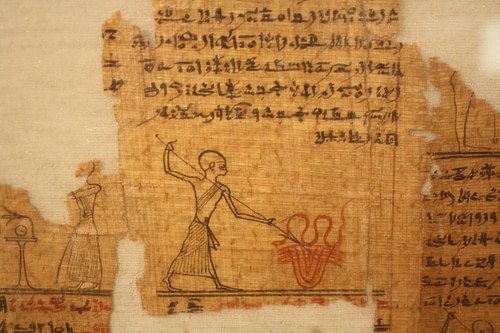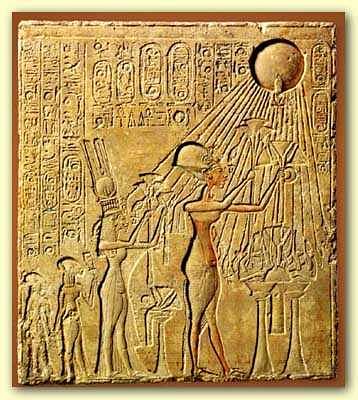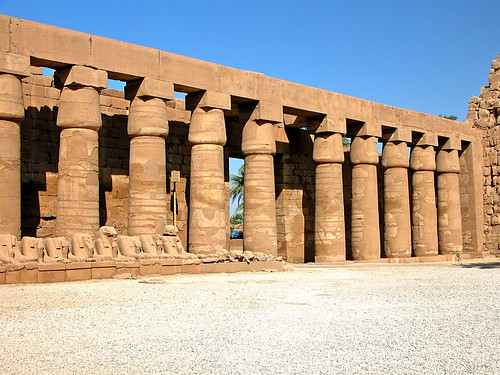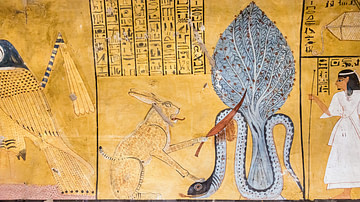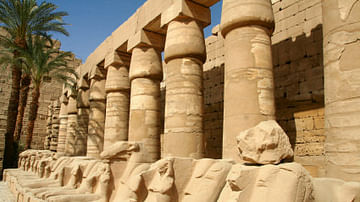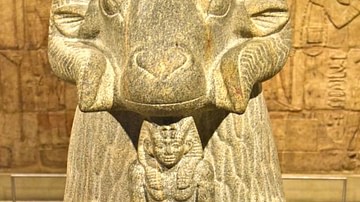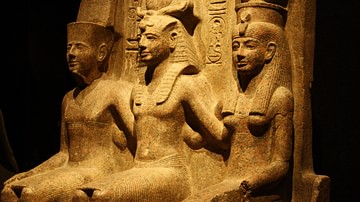The ancient Egyptians understood that their gods had prevailed over the forces of chaos through the creation of the world and relied upon humanity's help to maintain it. The people of Mesopotamia held this same belief but felt they were co-workers with the gods, laboring daily to hold back chaos through even the simplest acts, but the Egyptians believed all they had to do was recognize how the world worked, who was responsible for its operation, and behave accordingly.
This behavior was directed by the central cultural value, ma'at (harmony and balance) which was sustained by an underlying force known as heka (magic). Heka (personified as the god Heka) had been present at the creation of the world, pre-existing the gods, and allowed those gods to perform their duties. All the people, by observing ma'at, helped to maintain the order established by the gods through heka, but a special class was responsible for honoring and caring for the gods daily, and this was the priesthood.
The clergy of ancient Egypt did not preach, interpret scripture, proselytize, or conduct weekly services; their sole responsibility was to care for the god in the temple. Men and women could be clergy, performed the same functions, and received the same pay. Women were more often priestesses of female deities while men served males, but this was not always the case as evidenced by the priests of the goddess Serket (Selket), who were doctors and both female and male, and those of the god Amun. The position of God's Wife of Amun, held by a woman, would eventually become as powerful as that of the king.
High priests were chosen by the king, who was considered the high priest of Egypt, the mediator between the people and their gods, and so this position had political as well as religious authority. The priesthood was already established in the Early Dynastic Period in Egypt (c. 3150-2613 BCE) but developed in the Old Kingdom (c. 2613-2181 BCE) at the same time as the great mortuary complexes like Giza and Saqqara were being constructed. Throughout Egypt's history, the priesthood would serve a vital role in maintaining religious belief and tradition while, at the same time, consistently challenge the authority of the king by amassing wealth and power which at times rivaled that of the crown.
Types of Priests
Male priests were known as hem-netjer and females as hemet-netjer (servants of the god). There was a hierarchy in the priesthood from the high priest (hem-netjer-tepi, 'first servant of god') at the top to the wab priests at the bottom. The wab priests carried out the essential but fairly mundane tasks of taking care of the temple complex and performing whatever function they were called upon for, such as helping to prepare for festivals.
In between these two positions was a wide array of priests who performed all kinds of duties in service to the gods: kitchen staff, janitors, porters, scribes, anyone who worked in the temple complex who had any association with the god was in some form a priest. Even the cult singers and musicians needed to have had some training in the priesthood to perform their duties, though probably not the kind of initiation or education which actual priests went through.

The hour-priests were astronomers who kept the calendar, determined lucky and unlucky days, interpreted omens and dreams. There were the doctors, who were also priests, the swnw (general practitioner) and the sau (magical practitioner) who both combined medicine and magic. A ka-priest (also known as a ka-servant) was paid by a family to perform the daily offerings at the tomb of the deceased.
There were also sem priests who presided over mortuary rituals and conducted funeral services. Sem priests were the embalmers who mummified the corpse and recited the incantations while wrapping the mummy. The sem priests were highly respected because they were responsible for the precise utterance of the spells which would guarantee eternal life to the deceased. An interesting exception was the sem priest who would make the actual incision in the body to remove the organs. However he was treated the rest of the time, after this procedure, he was ritually insulted by his peers and chased down the road, most likely to ward off evil spirits associated with causing injury to the body.
Just below the high priest was the lector priest (hery-heb or cheriheb) who wrote down the religious texts, instructed other clergy, and recited the "authoritative utterance," the heka, in the temple and at festivals. Although there is evidence of women serving in all other positions in temple life, there is no record of a female lector priest. This could have been because the position was usually passed from father to son.
Besides the high priest, most of these positions were part-time. Priests and priestesses were divided into 'watches' and would serve the temple one month in every four. When their month of service was up, they returned to their regular jobs in the community which were usually those of mid-level bureaucrats. While they were in service, priests lived in the temple complex. They were expected to be ritually pure, bathe a number of times a day, and be able to carry out the duties required of them.
Duties & Rituals
Although the details are unclear, the clergy had to undergo some kind of initiation ritual before assuming their position. It has been suggested that the Negative Confession, the list of sins one could honestly claim one had not committed, was originally part of this initiation ritual. By the time of the New Kingdom of Egypt (c. 1570-1069 BCE) the Negative Confession was entirely associated with judgment by Osiris in the afterlife and included in The Egyptian Book of the Dead but most likely developed earlier as an affirmation that a person was worthy of serving the god.
There were as many duties and rituals as there were priests, but the high-ranking clergy participated daily in two which were considered of utmost importance: Lighting the Fire and Drawing the Bolt. In the fire ritual, the priests would gather before dawn in a sacred room close to the god's shrine and re-enact the first appearance of the sun by lighting a fire in a brazier. The boat of the sun god was thought to pass through the underworld at night where it was threatened by the serpent Apophis. Rituals were often observed to help the sun god navigate his nightly trip safely and defeat Apophis and lighting the morning fire was among these.
Following Lighting the Fire came Drawing the Bolt which was when the door was unlocked to the shrine room where the statue of the god resided. Only the high priest could enter this inner sanctum because it was believed the god or goddess lived in the statue and one was entering sacred space. The high priest was considered sanctified enough to share the presence of the god but no one else until the New Kingdom when the office of God's Wife of Amun was elevated under Ahmose I (c. 1570-1544 BCE). The God's Wife of Amun became the female counterpart of the high priest and some of the God's Wives had previously been high priestesses. The priest would wash and dress the statue, and then those of lesser rank would provide food and drink which was brought to the god and left in the room. When it was thought the god had supernaturally absorbed these offerings, they were removed from the room and dispensed to the temple staff.
Throughout the day the priests, priestesses, singers, musicians, and others performed many different rituals at the temple and in the temple complex. One important feature of temples was the institution known as the Per-Ankh (House of Life) which was part library, writing center, scriptorium, conference center, and institute of higher learning. Religious and medical texts were written, copied, studied, and discussed there, and it may have been where young priests and doctors were educated. Besides activities at the Per-Ankh, rituals were performed to honor lesser deities associated with the main god of the temple, to honor deceased kings, queens, or other people of note, and to ensure fertility and health in the land.
None of these rituals involved a weekly service where the people would come to worship the god and hear the priest or priestess speak. The people already understood how the world worked and what was expected of them and did not need any ecclesiastical authority to instruct them. There is evidence that people came to the temple for help with medical, financial, and emotional needs as well as to request protection against evil spirits or ghosts, and it is also clear they would bring offerings to the temple in gratitude for prayers answered. For the most part, however, the people of Egypt interacted with their gods privately or during the many festivals held throughout the year. The priests served the gods, not the people.
Evolution of the Priesthood
In time, however, the priests began to serve themselves more than either. There is evidence of this tendency beginning in the Old Kingdom of Egypt, actually, after the establishment of the grand royal necropolis at Giza. Giza in the Old Kingdom was not the lonely, wind-swept plateau of sand it is today, but a thriving community of state workers, merchants, craftsmen, and priests. These priests were responsible for providing the daily offerings and conducting the rituals which allowed for the continued journey in the afterlife of the kings.
One of the contributing factors to the collapse of the central government at the end of the Old Kingdom was that the king had exempted the priesthood from paying taxes. The priests not only lived off the offerings given to the gods but were able to profit from the land they owned, whose bounty was out of reach of the royal treasury. There is not a single period in Egyptian history in which this paradigm is not evident. It has been suggested, and is entirely probable, that the religious reforms of Akhenaten (1353-1336 BCE) in the New Kingdom were more of a political maneuver to undercut the power of the priesthood than a sincere effort at religious reform.
By the time of Akhenaten, the cult of Amun had grown so powerful and wealthy that they rivaled the king. The position of God's Wife of Amun, held by royal women at the Temple of Karnak at Thebes, had begun as an honorary title in the late Middle Kingdom of Egypt (2040-1782 BCE) but, by the New Kingdom, was a powerful post, and in the Third Intermediate Period (c. 1069-525 BCE), the daughter of King Kashta (c. 750 BCE), Amenirdis I, effectively ruled Upper Egypt from Thebes as God's Wife. Akhenaten, who was probably not as mystically-inclined nor as politically inept as he is depicted, recognized the danger of the cult of Amun becoming too powerful and so tried to prevent this through the establishment of monotheism.
His efforts were in vain, however, not only because he was fighting against over 2,000 years of religious tradition but, on the purely practical level, too many people owed their livelihood to the temple and worship of the gods. After his death, his son Tutankhamun (c. 1336-1327 BCE) abolished his father's religion and returned to the old ways, and these reforms were completed by Horemheb (1320-1292 BCE) who erased Akhenaten's name from history in outrage at his impiety.
Degeneration & Disappearance
The priesthood was therefore allowed to flourish and became especially powerful at Thebes. Amun increasingly was regarded as the King of the Gods and became the political power at Thebes through his grand temple at Karnak and the manipulations of the priesthood there.
According to scholar Marie Parsons, by the time of the reign of Ramesses III (1186-1155 BCE) in the later New Kingdom, the priests of the various cults held more power and wealth than the pharaoh; especially the priests of Amun. Parsons writes:
During the reign of Ramesses III, the temple of Amun at Karnak comprised 433 orchards, 421,000 head of livestock, 65 villages, 83 ships and 46 workshops, with hundreds of acres of farmland, and a total labor force of more than 81,000. The temple of Ra at Heliopolis owned hundreds of acres, 64 orchards, 45,544 head of livestock, 103 villages, 3 ships and 5 workshops, with a personnel force of 12,700. The overseers of the estates and granaries, scribes, soldiers, all reported to the high priests of their temple. (4)
Just as Akhenaten may have feared, the power of the priests compromised the position of the king. In the Third Intermediate Period of Egypt, Amun was effectively the ruler of Thebes and Upper Egypt. Instead of the pharaoh interpreting the will of the gods for the people and acting as supreme high priest, the priests consulted the gods directly and interpreted their answers. Civic and criminals cases, matters of policy, domestic issues, building policies, were all decided at Thebes by Amun whose will was then interpreted and implemented by the priests. Egyptologist Marc van de Mieroop writes:
The god made decisions of state in actual practice. A regular Festival of the Divine Audience took place at Karnak when the god's statue communicated through oracles, by nodding assent when he agreed. Divine oracles had become important in the 18th Dynasty; in the Third Intermediate Period they formed the basis of governmental practice. (266)
Throughout the Third Intermediate Period and Late Period of Ancient Egypt (525-332 BCE), the priests continued to hold this level of power but the priesthood began to degenerate as offices were bought and sold. Egyptologist Margaret Bunson comments on this:
In time the priests would witness the downfall of their own shrines and temples and others of their ranks would enter the political world with ambitions. Even the role of the priesthood would be bartered away or squandered for gain. (209)
The priests maintained their position, with greater or lesser degrees of success, through the Ptolemaic Dynasty (332-30 BCE) and even into the later Roman Egypt, but by the time of the ascent of Christianity in the 4th century CE, they had lost most of their prestige and power and had largely betrayed their positions for material wealth and personal power. It was in partly because of the degeneration of the priesthood that Christianity was able to gain such influence in Egypt and eventually replace the old faith with a new one.

